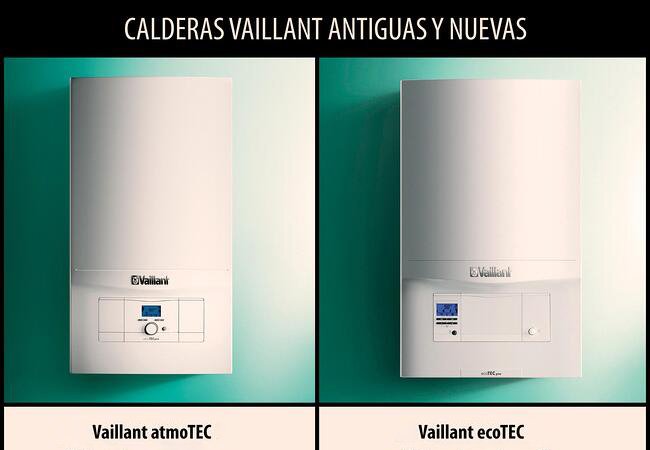When we use the term “old Vaillant boilers”, we are not only referring to older model Vaillant boilers, but also to all boilers that use technology that has now become obsolete. Ever since the ErP and ELD regulations came into force in 2018, many technologies that are now considered polluting technologies have been banned. They are now not permitted to be sold or manufactured. This kind of technology is currently considered as being old and also includes atmospheric boilers, which were just the other day considered as state-of-the-art technology boilers. This article will discuss this interesting and important topic in detail.
What criteria are used to discontinue a product?
It is normal practice for companies that manufacture boilers to discontinue products. This can be due to various reasons:
- Because there is not enough demand for the product to dedicate resources to manufacturing it
- Following the current trends and dynamics in the market
- They are no longer being sold as the competitor has created something better
- Due to changing laws in the relevant sector
- And mostly because the company has been able to design a superior product, which can replace the discontinued one
If you were to look at relatively recent atmospheric boiler marketing catalogs (prior to 2018), you would notice that they were still selling these marvels. This is still true to this day as many company websites include a category for discontinued products, or at least provide their user manuals. In the case of Vaillant, you can browse the brand’s list of discontinued products by clicking on the following link:
Click here to browse the list of discontinued products on the Vaillant website
You can do this because, although the products have been discontinued, many people still continue to use them. The new regulations even take this into account because even though it’s now against the law to manufacture or sell atmospheric boilers, this is not the case if you have one already installed. In this case, you do not need to replace it. It is only if you are installing a new boiler that you would need to install either a watertight, low NOx or condensing boiler if possible.

Comparison between old and new Vaillant boilers
If we consider, for instance, the Vaillant atmoTEC / turboTEC boiler which has atmospheric technology (which was state-of-the-art at the time), and compares it with the current and brand new Vaillant ecoTEC (condensing) boiler, we will immediately see the differences. The former is considered to be “old Vaillant boilers”, even though they are not that old and actually have a contemporary and modern look. In fact, they look very similar to the ecoTEC model. However, it is not about looks but about outdated technology. Let’s take a look at a brief comparison:
| Parameter | Vaillant atmoTEC/turboTEC | Vaillant ecoTEC |
|---|---|---|
| Boiler type | Atmospheric | Modulating condenser |
| Noise level | Noisy | Silent |
| Gas expulsion | Modulating system | Watertight |
| Energy efficiency | 35% efficient | 108% efficient |
| Pollution level | High | Low |
| Gas temperature | High | Low |
| Fuel expenditure | High | Medium |
The new regulations and atmospheric boilers
The new ErP and ELD regulations by the European community aim to regulate, promote, and standardize the ecological design and energy efficiency of machinery working with energy. This is to help reverse short, medium, and long-term climate change, which is the most pressing problem facing civilization on planet Earth today.
In a direct sense and in reality, the new regulations do not expressly prohibit the manufacturing of atmospheric boilers or any specific machinery, nor do they encourage the manufacturing and marketing of any specific machinery. However, these regulations establish strict ecological design parameters that, in practice, exclude atmospheric technology in heating and domestic hot water (DHW) equipment.

People have been advised to trade their old heating equipment with ones that use cleaner technology. However, this is not mandatory. In new installations, it is a requirement that minimum or low NOx units are used. This mainly applies to residential use. In the commercial sector, there is still a bit of leeway, as long as the unit complies with certain parameters.
Strictly speaking, the only boilers that are currently allowed to be manufactured are low NOx boilers, which are units using watertight and condensing technology. This is how the ERP regulations prohibit the manufacturing and selling of heating equipment that don’t have low levels of polluting emissions. Below are some interesting links about the new regulations in force:
- ErP: Official text from Directive 2009/125/EC of the European Parliament and Council (PDF)
- ELD: Official text from Directive 2010/30/EU of the European Parliament and Council (PDF)
- R.I.T.E.: Official text from the Royal Decree 1027/2007 (Online)
- Official text from the Royal Decree 187/2011 (PDF)
It is safe to say that the new ErP and ELD regulations are achieving their goal of reducing pollutants from machinery. There is no doubt about it that Vaillant boilers (which have been driven by the new laws in ecological design) are the winners in terms of energy efficiency and reducing polluting emissions. We can therefore say that it’s a good thing that atmospheric boilers are considered “old Vaillant boilers”.

